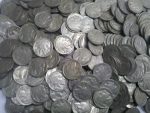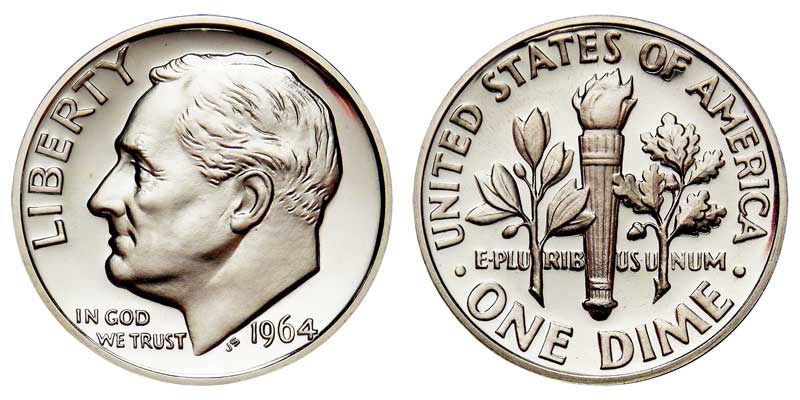Today, in lieu of our regular column of Economics & Investing news items, I’m posting my retrospective on the long-term legacy of currency debasement in the United States. I chose to do so this week because Richard M. Nixon’s Day of Perfidy was 50 years ago, earlier this month.
The U.S.: 50 Years in Currency Fantasyland
It was 50 years ago, in August of 1971, that the United States finally severed its last vestige of a gold standard. This came when President Nixon announced that the Treasury “temporarily” ceased redemption in gold of U.S. Dollars presented by foreign governments. He blamed this move on “currency speculators”, but the real culprits were the over-spenders in the U.S. Congress.
Ever since August of 1971, the U.S. Dollar has been entirely free-floating, backed by nothing! So, for the past 50 years in America, we’ve been living in a currency fantasyland. Congress, the U.S Treasury, the Federal Reserve private banking cartel, and the U.S. Mint have all ignored all seven of the money clauses in the U.S. Constitution. For the past 56 years (since 1965) we haven’t had real “Dollars” or “money” as defined by the Constitution. Instead, we’ve had fiat currency. Many people use the terms money and currency interchangeably. But they really mean two quite different things. The free-floating so-called “Dollar” (Federal Reserve Note) has triggered massive waves of inflation.
No More Silver Dollars
 Long before the last straw in 1971, our government began withdrawing from its bi-metallic currency system. In 1935, the U.S. Mint ceased minting any new 90% silver dollars for public circulation. (The Eisenhower “silver” dollar was minted from 1971 to 1974, but except for a few 90% silver ones made for special noncirculating proof sets, the “Ikes” were all 75% copper and 25% nickel.)
Long before the last straw in 1971, our government began withdrawing from its bi-metallic currency system. In 1935, the U.S. Mint ceased minting any new 90% silver dollars for public circulation. (The Eisenhower “silver” dollar was minted from 1971 to 1974, but except for a few 90% silver ones made for special noncirculating proof sets, the “Ikes” were all 75% copper and 25% nickel.)
No More Gold Pieces
 In 1933 the Mint ceased minting any new gold coins. Also, on June 5, 1933, via Executive Order 6102 (signed three months earlier by Franklin D. Roosevelt) gold coins were forcefully taken out of circulation, paying $20 per Troy ounce ($20 paper or silver dollars for each $20 gold piece). This same Executive Order made it illegal for U.S. citizens to hold any gold coins except for a few high-grade collectors’ coins. Then, in 1934, the U.S. government had the temerity to raise the official value of gold to $35 per Troy ounce–in effect robbing the former holders of gold of 43% of the value of what they had just recently surrendered.
In 1933 the Mint ceased minting any new gold coins. Also, on June 5, 1933, via Executive Order 6102 (signed three months earlier by Franklin D. Roosevelt) gold coins were forcefully taken out of circulation, paying $20 per Troy ounce ($20 paper or silver dollars for each $20 gold piece). This same Executive Order made it illegal for U.S. citizens to hold any gold coins except for a few high-grade collectors’ coins. Then, in 1934, the U.S. government had the temerity to raise the official value of gold to $35 per Troy ounce–in effect robbing the former holders of gold of 43% of the value of what they had just recently surrendered.
No More 90% Silver Dimes or Quarters
Fast forward to 1964, and the Treasury ceased minting the long-established 90% silver dimes and quarters. Starting in 1965, they were replaced by “clad” coins that are a sandwich of 75% copper on the inside and 25% nickel on the outside.
No More 40% Silver Half Dollars
For the sake of window dressing, the U.S. continued to mint silver Half Dollars, albeit with a debased 40% silver content. This was from 1965 until 1971.
On June 24, 1968, the Treasury repudiated Silver Certificates, declaring that they could no longer be redeemed in silver dollars “On Demand.” Shame on them.
The Coin Shortage of 1965 to 1968
In early 1965, the Generally Dumb Public (GDP) finally caught on, and quickly began gleaning virtually all of the 90% silver coins out of circulation, to hoard them. This explains why you now see so many 1964-dated dimes, quarters, and half dollars in near mint condition at coin shops: They were gleaned out of circulation just as soon as they made it to local banks. Unlike their predecessors, the 1964 mint date coins never picked up any “pocket wear.”
 The number of people hoarding silver coins was so great that it caused a nationwide three-year coin shortage. Today, the only 90% silver coins that slip into circulation do so by mistake. Nobody consciously and willingly spends a 90% silver coin at face value when it has a genuine silver value that is 22 times greater than the debased coins now in circulation. This is Gresham’s Law, in action. “Bad Money Drives Out Good.”
The number of people hoarding silver coins was so great that it caused a nationwide three-year coin shortage. Today, the only 90% silver coins that slip into circulation do so by mistake. Nobody consciously and willingly spends a 90% silver coin at face value when it has a genuine silver value that is 22 times greater than the debased coins now in circulation. This is Gresham’s Law, in action. “Bad Money Drives Out Good.”
A side note: You can still occasionally find 1965-to-1971 40% silver half dollars in circulation. Grab them when you find them! Some people make a hobby of this.
No More Copper Pennies
In 1981, inflation had made even the copper penny worth more than its face value. The U.S. Mint began cranking out zinc slugs that are flashed with copper to make them outwardly look like genuine copper pennies.
The Humble Nickel: The Sole Survivor
 The U.S. nickel (five-cent piece) is the sole survivor–the last circulating U.S. coin that still has its original composition (homogenous 75% copper and 25% nickel.) Despite their weight and bulk, that is why I’ve long recommended hoarding them. With ongoing inflation, it is inevitable that they too will be replaced with some form of debased slug. I thought that would happen years ago, but thankfully it has not. This has given us time to stack our nickels deep.
The U.S. nickel (five-cent piece) is the sole survivor–the last circulating U.S. coin that still has its original composition (homogenous 75% copper and 25% nickel.) Despite their weight and bulk, that is why I’ve long recommended hoarding them. With ongoing inflation, it is inevitable that they too will be replaced with some form of debased slug. I thought that would happen years ago, but thankfully it has not. This has given us time to stack our nickels deep.
Early Inflation
America’s history of currency shenanigans did not begin in the 1930s. It began even before there was a functioning “United States”, with the Continental Currency. That paper “silver” currency originated in 1775, primarily as a way to finance the nascent War of Independence. Eventually, there were 241 million “Continental” paper dollars issued. Meanwhile, individual states circulated another 51 million paper “dollars.” People soon caught on to this ruse and demanded ever-increasing numbers of paper Continentals in exchange for one silver dollar. (In those days, it was primarily Spanish milled silver dollars that were in circulation.) Finally, in 1781, the value of the Continental notes collapsed entirely, and they were fully repudiated. That is where the phrase “not worth a Continental” comes from. A similar cycle took place in the early 1860s, with the issuance of Greenbacks by the Northern States and Confederate currency by the seceding Southern states.
Inflation in the Modern Era
Now, let’s get back to examining “money” in the present day: If you visit any of the online Inflation Calculators, or look at a graph of the purchasing power of the U.S. Dollar, it is plain to see that the modern era of inflation began during World War I. But it really took off after 1964–the last year that circulating 90% silver coins were minted. It was no coincidence that it was at this point that the Federal government had the green light to spend recklessly. President Lyndon B. Johnson wanted both Vietnam War spending and “The Great Society” welfare spending. Sadly, Congress acquiesced, and he got both.
They’re All Doing It
The only reason that the U.S. Dollar hasn’t collapsed in value on the FOREX market since 1971 is that all of the nations of the world began debasing their currencies, starting in the 1950s. There are now no major currencies that are redeemable for precious metals by the general public. In effect, all of the national Treasuries are in a proverbial Race To The Bottom. Some of them are just faster than others. It is also noteworthy that whenever any national leader begins demanding a new redeemable currency, a war begins. (If you have some time, do a web search on “gold dinars.”)
I hope that you found this brief essay of interest. If nothing else, it explains why I recently changed the pricing of my antique guns at Elk Creek Company to pre-1965 silver coins. I still take Federal Reserve Notes (FRNs), but at a multiplier that changes often. So I’m now fairly safe from the effects of currency inflation, even if it worsens substantially.
Hedge, Hedge, Hedge…
My advice in SurvivalBlog has always been to hedge into precious metals, especially silver. Now that inflation is increasing rapidly, I urge you to put at least 15% of your liquid net worth into silver. Dollar for Dollar, it is accumulating non-numismatic (“junk”) pre-1965 dimes, quarters, and half dollars that is the most affordable way to do so. The more you buy at a time, the lower the premium that you’ll pay. (A $1,000 face value bag carries a lower dealer premium than a $100 bag.) Most coin shops still have plenty of 90% silver coins available. Stock up! – JWR










